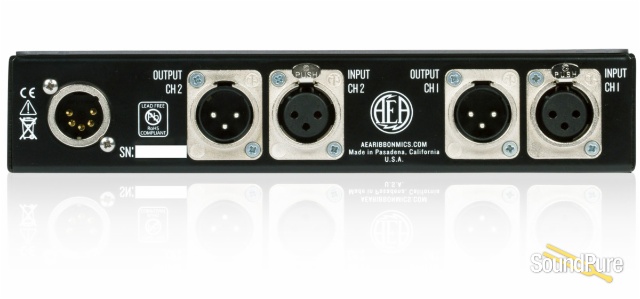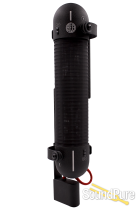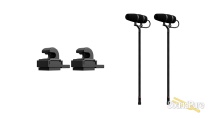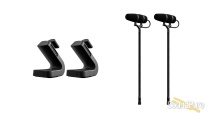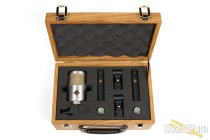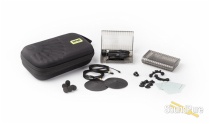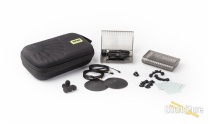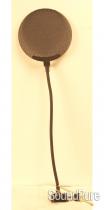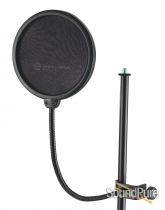-
Call Us Toll Free888-528-9703
-
Local/International (+1)919-682-5552
- Call Us! Toll Free! 888-528-9703
- Local / International (+1) 919-682-5552

AEA T.U.S.K. Bundle R88mk2 + TRP 2 From AEA
The Ultimate Stereo Kit! Combining the astounding stereo image of the world-reknowned R88mk2 Stereo Ribbon Mic and AEA's form-fitted to perfection TRP2 preamp yields some incredible stereo miking results. Now bundled together at a great price!
Available for Special Order
See something you like? This item is gone, but not forever. It can be special ordered, and even customized!
We can get it fast!
Because of our special relationship with AEA we can get this as fast, or faster than anyone in the industry. In some cases, we even have preferred build slots we can offer you.
Want to know when one lands?
Notify MeWant to discuss a special order?
Manufacturer's Description from AEA
R88mkII Stereo Ribbon Microphone
Big Ribbon™ Blumlein (XY) and MS stereo ribbon mic
Pure Ribbon™ design with open and natural sound
Used in many Grammy Award winning projects
Great foundation for main or sectional pickup
Being There in Stereo
In the 1930s, EMI engineer Alan Blumlein invented stereo recording by demonstrating the natural reproduction of the soundstage at one of the Abbey Road studios in London, UK. Still today, his coincident recording technique using two figure-of-8 ribbons is the benchmark for producing an authentic representation of a performance in a room. The R88 mk2 stereo microphone is a true Blumlein recording system optimized for recording instruments and ensembles in stereo. It utilizes two of AEA’s signature Big RibbonTM elements angled at 90 degrees and mounted in close proximity to each other along the vertical axis of the microphone. The natural soundstage and character of the R88’s Blumlein stereo make it a great main mic. As an alternative to the Blumlein (XY) technique, the microphone can also be used for MS stereo, providing excellent mono compatibility and full control over the width of the stereo image. An excellent orchestral and choral recording microphone, it also shines on applications such as horn sections and drum overheads, thanks to the pure sound of two undamped long ribbons and the passive circuit without the headroom limitations of active electronics. The R88 accurately records complex tones such as woodwinds, strings and cymbals.Whether it’s at Abbey Road or in your home studio, the R88 mk2 puts the listener right there with the performers in the recording room.
The Grammy-Winning Package
The list of Grammy and Academy Award winning projects recorded with the help of the R88 mk2 microphone is long and keeps growing: Turtle Island String Quartet, Los Tigres Del Norte, Juanes MTV Unplugged, Life Of Pi soundtrack to name but a few. The matched Blumlein pair of ribbons packaged in a sleek black shell designed for quick setup delivers a great sound right off the bat, making it an excellent choice for remote recording setups. As a drum overhead or room pick-up microphone, it instantly captures a punchy, “larger than life” image that is particularly well suited for rock, roots, Americana, and jazz genres. Seasoned engineers like Joe Chiccarelli, Chuck Ainlay or Vance Powell trust the AEA R88 mk2 so much that Nashville’s world-class Blackbird Studios now has an R88 available for every single room in their facility.
A Big Ribbon for a Big Sound
At the heart of the AEA R88 are two big, 2.35" by 0.185" by 2 micron pure aluminum low-tension ribbon elements just like the one used in the classic R44. Many ribbon mic manufacturers choose shorter ribbons that are easier to install, but AEA’s Large Ribbon Geometry TM design offers important advantages. Ribbon microphones operate linearly above their resonant frequency, unlike condenser or moving-coil transducers, so the resonant frequency of a good ribbon microphone design should be as low as possible. The longer the ribbon, the lower the resonant frequency will be. The ribbon has to move twice as far for every drop in octave as it vibrates within the magnetic gap, thus a longer ribbon will allow for further movement back and forth. This results in the ribbon handling louder sound sources and more sound pressure level (SPL). Most AEA ribbons are tuned to just 16.5 Hz, and because the R88 shares the same Big Ribbon™ as the rest of AEA's product line, you will achieve a sound that is smooth, natural and free from any of the uncomfortable resonances that shorter ribbons and condensers can exhibit. The result is a sound that many engineers say is astonishingly close to what their ears hear when they are actually standing in the studio.
TRP2 Stereo Ribbon Microphone Preamp
ENHANCE YOUR RIBBONS
The AEA TRP2 Ribbon Preamp provides two channels of high-output, high-impedance, and low-noise gain with a rich and natural sound that brings out the full potential of your microphones. Specifically designed for ribbon microphones, the TRP2 excels at drawing out the warmth and lush sound that ribbons are uniquely known for.
A GAIN POWERHOUSE
The TRP2 is a powerhouse that provides unparalleled high gain with low-noise. With 85db of JFET output, the TRP2 gives you enough juice to record soft sources without ever having to worry about noise. With the TRP2, you will never consider a source too quiet to record with a ribbon mic ever again. Passive ribbons with low output levels require preamps that supply a high level of output. If the preamp you use doesn’t have enough clean gain, the mic signal may seem too soft or noisy which may be apparent when recording quiet acoustic guitars or strings, especially at a distance or with long cable runs. The TRP2 eliminates this concern.
PROFESSIONAL FEATURES IN A COMPACT PACKAGE
The TRP2 is AEA’s second iteration of the high-performance TRP preamp with the addition of new features including phantom power, optional rack ears, and a switching power supply.Polarity reverse switches for ensuring proper polarity throughout the recording chain and switchable 100 Hz, 12 dB per octave low-frequency filters allow you to tame proximity problems. The TRP2 includes switchable phantom power that is capable of powering condensers and active ribbons. For engineers concerned about phantom power hurting their passive ribbons, there is phantom power kill switch, known as No Blow Mode, located internally within the unit that easily deactivates 48V from ever turning on.
HIGH IMPEDANCE MAKES A HUGE DIFFERENCE
The sound and tonality of dynamic microphones like ribbons and moving-coils are directly affected by the impedance of a preamp. The higher the impedance, the better the sound. The RPQ2 boasts an extra high input impedance of 63K Ohms. Preamps with an impedance of under 10k ohms will limit the lows, highs, and transients of your passive microphones. The RPQ2’s high impedance will reveal your microphone’s true nature– a thick low-end, open top-end, and articulate transient response that you will need to hear to believe. Both condensers and active microphones will also benefit from the RPQ2’s impedance.
A UNIVERSAL POWER SUPPLY
An external switching power supply with a grounded AC plug is used with the TRP2 so hum fields can be kept away from the high-gain electronics. The power supply allows the TRP2 to be used in any country without any modifications made to the unit.
OPTIONS TO RACK THE TRP
The TRP2 is housed in a portable and lightweight half-rack aluminum chassis. This form factor allows you to easily take it to remote gigs, other studios, and on the road. The TRP2 can be easily racked with the optional TRP2 Rack Ears. Attach the rack ears to the TRP2 and unit can be securely installed in any standard rack. Two TRP2s can be mounted side by side in a single rack space by purchasing the AEA TRP2 Rack Shelf. Screwing two TRP2s to the rack shelf, the whole assembly can be securely installed in any standard rack.
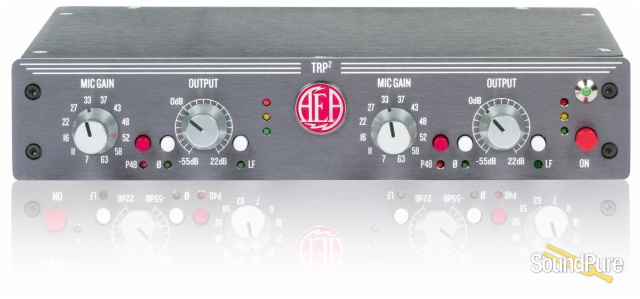
About Manufacturer
Wes Dooley's longtime passion for audio has infused his company, Audio Engineering Associates (AEA), with a well balanced blend of creativity and technical expertise for forty years. At the core of AEA is a genuine interest in the art and science of audio. From areas as diverse as forensic audio and microphone design, Wes' passion for audio has led him all over the world, from recording experiences in Europe, Africa, and New Zealand, to the courtrooms of Los Angeles as a forensic audio and video expert witness. Such experiences have led Wes to design products which help resolve problems commonly encountered by recording engineers. His portable recording tools including, multi-channel microphone arrays, MS stereo processors, stereo phase displays and very tall microphone stands, have all made on-site recording far more feasible. Despite his contributions to on-location recording, Wes is best known for his pursuit of excellence in ribbon microphone technology. After two decades of representing and servicing the BBC 4038 in the United States, he began to experiment with his own ribbon microphones. During the last decade Wes became aware of the increasing scarcity of R44's and other ribbon microphones. In 1998, responding to this need, Wes re-introduced the 44 much to the thrill of many in the recording industry. Les Paul told Wes that AEA's R44 is his favorite microphone and engineer/producers such as Bruce Swedien, Kevin Bacon, and Shawn Murphy routinely use AEA's R44. Even without such critical acclaim the numbers speak for themselves. Over half of the movies scored in Los Angeles have a 44 somewhere on the scoring stage. Building off of his successful reintroduction of the R44, in 2002 Wes designed and began producing an original ribbon mic, the AEA R84. His groundbreaking work with ribbon microphones helped him to secure the Audio Engineering Society (AES) Silver Medal Award in the fall of 2003. This award, established by the AES in 1971, in honor of audio pioneers Alexander Graham Bell, Emile Berliner, and Thomas A. Edison, is given in recognition of outstanding development or achievement in the field of audio engineering. Wes has also co-authored two AES Journal articles about stereo microphone techniques, chaired workshops on mic techniques and mixing strategies for compatible multiple releases for cinema, broadcast and home video, and has presented section meetings on stereo techniques and forensic audio. He is involved with AES standards work and currently serves on the SC-03-12 Working Group on Forensic Audio and SC-04-04 Working Group on Microphone Measurement and Characterization.
Specifications
R88mkII Stereo Ribbon Microphone
Transducers: dual 2" ribbons oriented at 90 degrees
Sensitivity: -52dBV/Pa
Frequency Response: 20Hz-15kHz (+/- 3dB)
Output Impendance: 270 ohms
SPL Handling: 165dB SPL at 1 kHz
Recommended Load: 1.2 K ohm or greater
Powering: Not required or recommended
Polarity: Pin 2 high
Connector: XLR-3M wired to a 4 meter captive stereo cable
Includes custom hard case with padded interior for storage and shipping
Operating manual for proper care and usage.
TRP2 Stereo Ribbon Microphone Preamp
Gain at 1kHz: 85dB of gain at 1kHz, balanced-in to balanced-out in Microphone Input mode
Noise figure, rms A-weighted: <2dB
Noise figure, rms unweighted: <3dB, 20 kHz LPF bandwidth
EIN: <-130 dBu A-weighted, 150 Ohm resistive source
THD: -3dB <1Hz and >100 kHz <0.02% at 1 kHz
Input impedance: 63K Ohms (10K Ohms when P48 is engaged)
Input Gain control: Twelve-position switch provides from +7dB to +63dB of gain for the preamplifier circuit, as measured between the input and the before the output line driver.
Switched LF Shelving filter: 12dB per octave from 100 Hz
Color LEDs: Yellow, Green, Red
XLR output maximum level into 600Ω load: +28 dBu, balanced; 0 dBu = 0.7746 V rms
XLR connectors polarity: Pin-1 is ground, pin-2 is high, pin-3 is low
LED signal level indicators: The green LED snaps on at -20 dBu to indicate the presence of signal; the yellow LED snaps on at 0 dBu; the red LED snaps on at +24 dBu to warn of approaching signal overload.
External Features:
An external switching power supply with a grounded AC plug is used with the TRP2 so hum fields can be kept away from the high-gain electronics. The power supply allows the TRP2 to be used in any country without any modifications made to the unit. The power supply uses a 5-pin XLR connector for its output. It has one 18 volt AC secondary winding, which is used within the TRP2 to provide three regulated DC voltages. Bi-polar 18-volt rails are provided for the electronics and a +12 volt rail for the Aeromat relays.
Dimensions
Size: 8.5” w, 8.5 d, 1.5” h (36.7 cm x 36.7 cm x 4.3 cm)
Weight: 2lbs oz (0.9 kg)
